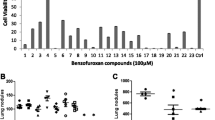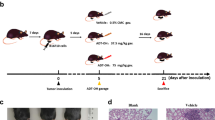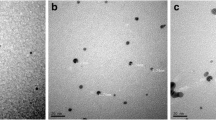Abstract
Cancer is one of the leading causes of mortality worldwide. Even with the advances of pharmaceutical industry and treatments, the mortality rate for various types of cancer remains high. In particular, phenotypic alterations of tumor cells concerning drug efflux, migratory and invasive capabilities may represent a hurdle for cancer treatment and contribute to poor prognosis. In the present study, we investigated the effects of polybrominated diphenyl ethers (PBDEs) used as flame retardants on phenotypic features of melanoma cells that are important for cancer. Murine melanoma B16-F1 (less metastatic) and B16-F10 (more metastatic) cells were exposed to 0.01–1.0 nM of BDE-47 (2,2′,4,4′-tetrabromodiphenyl ether), BDE-99 (2,2′,4,4′,5-pentabromodiphenyl ether), and the mixture of both (at 0.01 nM) for 24 h (acute exposure) and 15 days (chronic exposure). The polybrominated diphenyl ethers (PBDEs) did not affect cell viability but led to increased drug efflux transporter activity, cell migration, and colony formation, as well as overexpression of Abcc2 (ATP-binding cassette subfamily C member 2), Mmp-2 (matrix metalloproteinase-2), Mmp-9 (matrix metalloproteinase-9), and Tp53 (tumor protein p53) genes and downregulation of Timp-3 (tissue inhibitor of metalloproteinase 3) gene in B16-F10 cells. These effects are consistent with increased aggressiveness and malignancy of tumors due to exposure to the flame retardants and raise some concerns on the effects such chemicals may have on melanoma treatment and cancer prognosis.







Similar content being viewed by others
Data availability
Data sharing is not applicable to this article as no datasets were generated or analyzed during the current study.
References
Anania MC, Sensi M, Radaelli E, Miranda C, Vizioli MG, Pagliardini S, Favini E, Cleris L, Supino R, Formelli F, Borrello MG, Pierotti MA, Greco A (2011) TIMP3 regulates migration, invasion and in vivo tumorigenicity of thyroid tumor cells. Oncogene 30:3011–3023. https://doi.org/10.1038/onc.2011.18
Bissel M (2018). Soft agar assay for colony formation. Bissel Lab. https:// www2.lbl.gov Accessed July 2018
Björklund M, Koivunen E (2005) Gelatinase-mediated migration and invasion of cancer cells. Biochim Biophys Acta 1755(1):37–69. https://doi.org/10.1016/j.bbcan.2005.03.001
Brito PM, Biscaia SMP, de Souza TL, Ramos AB, Leão-Buchir J, de Almeida Roque A, de Lima Bellan D, da Silva Trindade E, Filipak Neto F, de Oliveira Ribeiro CA (2020) Oral exposure to BDE-209 modulates metastatic spread of melanoma in C57BL/6 mice inoculated with B16-F10 cells. Chemosphere 260:127556. https://doi.org/10.1016/j.chemosphere.2020.127556
M. D., Brooks SA (2001) In Vitro Invasion Assay Using Matrigel®. In: Brooks S.A., Schumacher U. (eds)Metastasis Research Protocols. Methods in Molecular Medicine™, vol 58. Humana Press, Totowa, NJ. https://doi.org/10.1385/1-59259-137-X:061
Chen H, Tang X, Zhou B, Xu N, Zhou Z, Fang K, Wang Y (2017) BDE-47 and BDE-209 inhibit proliferation of Neuro-2a cells via inducing G1-phase arrest. Environ Toxicol Pharmacol 50:76–82. https://doi.org/10.1016/j.etap.2016.12.009
Chen C, Zhao S, Karnad A, Freeman JW (2018) The biology and role of CD44 in cancer progression: therapeutic implications. J Hematol Oncol 11(1):64. https://doi.org/10.1186/s13045-018-0605-5
Cheung KC, Zheng JS, Leung HM, Wong MH (2007) Exposure to polybrominated diphenyl ethers associated with consumption of marine and freshwater fish in Hong Kong. Chemosphere 70(9):1707–1720. https://doi.org/10.1016/j.chemosphere.2007.07.043
Eckford PD, Sharom FJ (2009) ABC efflux pump-based resistance to chemotherapy drugs. Chem Rev 109(7):2989–3011. https://doi.org/10.1021/cr9000226
Fernandez MF, Araque P, Kiviranta H, Molina-Molina JM, Rantakokko P, Laine O, Vartiainen T, Olea N (2007) PBDEs and PBBs in the adipose tissue of women from Spain. Chemosphere 66(2):377–383. https://doi.org/10.1016/j.chemosphere.2006.04.065
Fidler IJ (1973) Selection of successive tumour lines for metastasis. Nat New Biol 242:148–149. https://doi.org/10.1038/newbio242148a0
Frederiksen M, Thomsen C, Frøshaug M, Vorkamp K, Thomsen M, Becher G, Knudsen LE (2010) Polybrominated diphenyl ethers in paired samples of maternal and umbilical cord blood plasma and associations with house dust in a Danish cohort. Int J Hyg Environ Health 213(4):233–242. https://doi.org/10.1016/j.ijheh.2010.04.008
Gialeli C, Theocharis AD, Karamanos NK (2011) Roles of matrix metalloproteinases in cancer progression and their pharmacological targeting. FEBS J 278(1):16–27. https://doi.org/10.1111/j.1742-4658.2010.07919.x
Gilham DE, Debets R, Pule M, Hawkins RE, Abken H (2012) CAR-T cells and solid tumors: tuning T cells to challenge an inveterate foe. Trends Mol Med 18(7):377–384. https://doi.org/10.1016/j.molmed.2012.04.009
Gomes LR, Fujita A, Mott JD, Soares FA, Labriola L, Sogayar MC (2015) RECK is not an independent prognostic marker for breast cancer. BMC Cancer 15:660. https://doi.org/10.1186/s12885-015-1666-2
He Y, Luo Y, Zhang D, Wang X, Zhang P, Li H, Ejaz S, Liang S (2019) PGK1-mediated cancer progression and drug resistance. Am J Cancer Res 9(11):2280–2302
Housman G, Byler S, Heerboth S, Lapinska K, Longacre M, Snyder N, Sarkar S (2014) Drug resistance in cancer: an overview. Cancers 6(3):1769–1792. https://doi.org/10.3390/cancers6031769
IARC (2013) Polychlorinated biphenyls and polybrominated biphenyls Volume 107. IARC, Lyon
IARC (2020) Global Cancer Observatory. Available in: https://gco.iarc.fr/. Access in December 2020.
Ichihashi N, Kitajima Y (2001) Chemotherapy induces or increases expression of multidrug resistance-associated protein in malignant melanoma cells. Br J Dermatol 144(4):745–750. https://doi.org/10.1046/j.1365-2133.2001.04129.x
Jiang H, Lin Z, Wu Y, Chen X, Hu Y, Li Y, Huang C, Dong Q (2014) Daily intake of polybrominated diphenyl ethers via dust and diet from an e-waste recycling area in China. J Hazard Mater 276:35–42. https://doi.org/10.1016/j.jhazmat.2014.05.014
Levine EA, Holzmayer TA, Roninson IB, Das Gupta TK (1993) MDR-1 expression in metastatic malignant melanoma. J Surg Res 54(6):621–624. https://doi.org/10.1006/jsre.1993.1095
Li ZH, Liu XY, Wang N, Chen JS, Chen YH, Huang JT, Su CH, Xie F, Yu B, Chen DJ (2012) Effects of decabrominated diphenyl ether (PBDE-209) in regulation of growth and apoptosis of breast, ovarian, and cervical cancer cells. Environ Health Perspect 120:541–546. https://doi.org/10.1289/ehp.1104051
Liang CC, Park AY, Guan JL (2007) In vitro scratch assay: a convenient and inexpensive method for analysis of cell migration in vitro. Nat Protoc 2:329–333. https://doi.org/10.1038/nprot.2007.30
Longo V, Longo A, Di Sano C, Cigna D, Cibella F, Di Felice G, Colombo P (2019) In vitro exposure to 2,2',4,4'-tetrabromodiphenyl ether (PBDE-47) impairs innate inflammatory response. Chemosphere 219:845–854. https://doi.org/10.1016/j.chemosphere.2018.12.082
Lu W, Kang Y (2019) Epithelial-mesenchymal plasticity in cancer progression and metastasis. Dev Cell 49(3):361–374. https://doi.org/10.1016/j.devcel.2019.04.010
Lv QY, Wan B, Guo LH, Zhao L, Yang Y (2015) In vitro immune toxicity of polybrominated diphenyl ethers on murine peritoneal macrophages: apoptosis and immune cell dysfunction. Chemosphere 120:621–630. https://doi.org/10.1016/j.chemosphere.2014.08.029
Madzharova E, Kastl P, Sabino F, Auf dem Keller U (2019) Post-translational modification-dependent activity of matrix metalloproteinases. Int J Mol Sci 20(12):3077. https://doi.org/10.3390/ijms20123077
Mazdai A, Dodder NG, Abernathy MP, Hites RA, Bigsby RM (2003) Polybrominated diphenyl ethers in maternal and fetal blood samples. Environ Health Perspect 111:1249–1252. https://doi.org/10.1289/ehp.6146
McDonald TA (2002) A perspective on the potential health risks of PBDEs. Chemosphere 46(5):745–755. https://doi.org/10.1016/s0045-6535(01)00239-9
Mondal S, Adhikari N, Banerjee S, Amin SA, Jha T (2020). Matrix metalloproteinase-9 (MMP-9) and its inhibitors in cancer: A minireview. Eur J Med Chem https://doi.org/10.1016/j.ejmech.2020.112260
Montalbano AM, Albano GD, Anzalone G, Moscato M, Gagliardo R, Di Sano C, Bonanno A, Ruggieri S, Cibella F, Profita M (2019) Cytotoxic and genotoxic effects of the flame retardants (PBDE-47, PBDE-99 and PBDE-209) in human bronchial epithelial cells. Chemosphere 245:125600. https://doi.org/10.1016/j.chemosphere.2019.125600
Noorolyai S, Shajari N, Baghbani E, Sadreddini S, Baradaran B (2019) The relation between PI3K/AKT signalling pathway and cancer. Gene 698:120–128. https://doi.org/10.1016/j.gene.2019.02.076
Oh J, Takahashi R, Kondo S, Mizoguchi A, Adachi E, Sasahara RM, Nishimura S, Imamura Y, Kitayama H, Alexander DB, Ide C, Horan TP, Arakawa T, Yoshida H, Nishikawa S, Itoh Y, Seiki M, Itohara S, Takahashi C, Noda M (2001) The membrane-anchored MMP inhibitor RECK is a key regulator of extracellular matrix integrity and angiogenesis. Cell 107(6):789–800. https://doi.org/10.1016/s0092-8674(01)00597-9
Overwijk WW, Restifo NP (2001). B16 as a mouse model for human melanoma. Curr Protoc Immunol. 20:Unit-20.1. https://doi.org/10.1002/0471142735.im2001s39, 39
Ozaki T, Nakagawara A (2011) Role of p53 in cell death and human cancers. Cancers 3(1):994–1013. https://doi.org/10.3390/cancers3010994
Pessatti ML, Resgalla JRC, Reis FRW, Kuehn J, Salomão LC, Fontana JD (2002) Variability of filtration and food assimilation rates, respiratory activity and multixenobiotic resistance (MXR) mechanism in the mussel Perna perna under lead influence. Braz J Biol 62(4A):651–656. https://doi.org/10.1590/S1519-69842002000400013
Qu BL, Yu W, Huang YR, Cai BN, Du LH, Liu F (2014) 6-OH-BDE-47 promotes human lung cancer cells epithelial mesenchymal transition via the AKT/Snail signal pathway. Environ Toxicol Pharmacol 39(1):271–279. https://doi.org/10.1016/j.etap.2014.11.022
Salgado YCS, Boia-Ferreira M, Zablocki da Luz J, Filipak Neto F, Oliveira Ribeiro CA (2018) Tribromophenol affects the metabolism, proliferation, migration and multidrug resistance transporters activity of murine melanoma cells B16F1. Toxicology in Vitro 50:40–46. https://doi.org/10.1016/j.tiv.2018.02.005
Shi Z, Jiao Y, Hu Y, Sun Z, Zhou X, Feng J, Li J, Wu Y (2013) Levels of tetrabromobisphenol A, hexabromocyclododecanes and polybrominated diphenyl ethers in human milk from the general population in Beijing, China. Sci Total Environ 452-453:10–18. https://doi.org/10.1016/j.scitotenv.2013.02.038
Sjödin A, Patterson DG Jr, Bergman A (2003) A review on human exposure to brominated flame retardants--particularly polybrominated diphenyl ethers. Environ Int 29(6):829–839. https://doi.org/10.1016/S0160-4120(03)00108-9
Tagliaferri S, Caglieri A, Goldoni M, Pinelli S, Alinovi R, Poli D, Pellacani C, Giordano G, Mutti A, Costa LG (2010) Low concentrations of the brominated flame retardants BDE-47 and BDE-99 induce synergistic oxidative stress-mediated neurotoxicity in human neuroblastoma cells. Toxicol in Vitro 24(1):116–122. https://doi.org/10.1016/j.tiv.2009.08.020
Takahashi C, Sheng Z, Horan TP, Kitayama H, Maki M, Hitomi K, Kitaura Y, Takai S, Sasahara RM, Horimoto A, Ikawa Y, Ratzkin BJ, Arakawa T, Noda M (1998) Regulation of matrix metalloproteinase-9 and inhibition of tumor invasion by the membrane-anchored glycoprotein RECK. Proc Natl Acad Sci U S A 95(22):13221–13226. https://doi.org/10.1073/pnas.95.22.13221
Tang S, Liu H, Yin H, Liu X, Peng H, Lu G, Dang Z, He C (2018) Effect of 2, 2', 4, 4'-tetrabromodiphenyl ether (BDE-47) and its metabolites on cell viability, oxidative stress, and apoptosis of HepG2. Chemosphere 193:978–988. https://doi.org/10.1016/j.chemosphere.2017.11.107
Taniguchi K, Wada M, Kohno K, Nakamura T, Kawabe T, Kawakami M, Kagotani K, Okumura K, Akiyama S, Kuwano M (1996) A human canalicular multispecific organic anion transporter (cMOAT) gene is overexpressed in cisplatin-resistant human cancer cell lines with decreased drug accumulation. Cancer Res 15;56(18):4124–4129
Tian PC, Wang HL, Chen GH, Luo Q, Chen Z, Wang Y, Liu YF (2016) 2,2',4,4'-Tetrabromodiphenyl ether promotes human neuroblastoma SH-SY5Y cells migration via the GPER/PI3K/Akt signal pathway. Hum Exp Toxicol 35(2):124–134. https://doi.org/10.1177/0960327115578974
Wang L, Zou W, Zhong Y, An J, Zhang X, Wu M, Yu Z (2012) The hormesis effect of BDE-47 in HepG2 cells and the potential molecular mechanism. Toxicol Lett 209(2):193–201. https://doi.org/10.1016/j.toxlet.2011.12.014
Wang F, Ruan XJ, Zhang HY (2015) BDE-99 (2,2',4,4',5-pentabromodiphenyl ether) triggers epithelial-mesenchymal transition in colorectal cancer cells via PI3K/Akt/Snail signaling pathway. Tumori 101(2):238–245. https://doi.org/10.5301/tj.5000229
Wang J, Wang Y, Shi Z, Zhou X, Sun Z (2018) Legacy and novel brominated flame retardants in indoor dust from Beijing, China: occurrence, human exposure assessment and evidence for PBDEs replacement. Sci Total Environ 618:48–59. https://doi.org/10.1016/j.scitotenv.2017.11.049
Wogan GN, Hecht SS, Felton JS, Conney AH, Loeb LA (2004) Environmental and chemical carcinogenesis. Semin Cancer Biol 14(6):473–486. https://doi.org/10.1016/j.semcancer.2004.06.010
Wu N, Herrmann T, Paepke O, Tickner J, Hale R, Harvey LE, La Guardia M, McClean MD, Webster TF (2007) Human exposure to PBDEs: associations of PBDE body burdens with food consumption and house dust concentrations. Environ Sci Technol 41(5):1584–1589. https://doi.org/10.1021/es0620282
Wu S, Powers S, Zhu W, Hannun YA (2016) Substantial contribution of extrinsic risk factors to cancer development. Nature 529:43–47. https://doi.org/10.1038/nature16166
Wu Z, He C, Han W, Song J, Li H, Zhang Y, Jing X, Wu W (2020) Exposure pathways, levels and toxicity of polybrominated diphenyl ethers in humans: a review. Environ Res 187:109531. https://doi.org/10.1016/j.envres.2020.109531
Yamaguchi H, Wyckoff J, Condeelis J (2005) Cell migration in tumors. Curr Opin Cell Biol 17(5):559–564. https://doi.org/10.1016/j.ceb.2005.08.002
Yan T, Lin Z, Jiang J, Lu S, Chen M, Que H, He X, Que G, Mao J, Xiao J, Zheng Q (2015) MMP14 regulates cell migration and invasion through epithelial-mesenchymal transition in nasopharyngeal carcinoma. Am J Transl Res 7(5):950–958
Zhang F, Peng L, Huang Y, Lin X, Zhou L, Chen J (2019) Chronic BDE-47 exposure aggravates malignant phenotypes and chemoresistance by activating ERK through ERα and GPR30 in endometrial carcinoma. Front Oncol 9:1079. https://doi.org/10.3389/fonc.2019.01079
Acknowledgements
The authors thank CNPq, CAPES, UFPR, and Fundação Araucária for funding this research and the Center for Advanced Fluorescence Technologies (CTAF) for technical support.
Funding
This study was supported by the Brazilian Council for Science and Technology Agency–CNPq (Finance Code 480707/2013-8, 428830/2018-8), Fundação Araucária de Apoio ao Desenvolvimento Científico e Tecnológico do Paraná (Finance Code 006/2017), Universidade Federal do Paraná (UFPR), and Coordination for the Improvement of Higher Education Personnel–CAPES (Finance Code 001).
Author information
Authors and Affiliations
Contributions
Gisleine Jarenko Steil: Investigation, formal analysis, and writing-original draft
João Luiz Aldinucci Buzzo: Formal analysis and writing-review and editing
Ciro Alberto de Oliveira Ribeiro: Conceptualization, project administration, resources, and writing-review and editing
Francisco Filipak Neto: Conceptualization, formal analysis, resources, supervision, visualization, writing-original draft, and writing-review and editing
Corresponding author
Ethics declarations
Ethics approval and consent to participate
Not applicable
Consent for publication
Not applicable
Competing interests
The authors declare no competing interests.
Additional information
Responsible editor: Ludek Blaha
Publisher’s note
Springer Nature remains neutral with regard to jurisdictional claims in published maps and institutional affiliations.
Highlights
B16-F1 and B16-F10 cells were exposed to BDE-47 and BDE-99 for 24 h and 15 days.
PBDEs did not affect cell viability, but the morphology of B16-F1 cells changed.
Activity of drug efflux transporters and Abcc2 expression increased in B16-F10 cells.
Migration and colony formation increased, and Mmp-9/Timp-3 expression was altered.
B16-F10 cells may become more aggressive and metastatic after exposure to both PBDEs.
Rights and permissions
About this article
Cite this article
Steil, .J., Buzzo, J.L.A., de Oliveira Ribeiro, C.A. et al. Polybrominated diphenyl ethers BDE-47 and BDE-99 modulate murine melanoma cell phenotype in vitro. Environ Sci Pollut Res 29, 11291–11303 (2022). https://doi.org/10.1007/s11356-021-16455-0
Received:
Accepted:
Published:
Issue Date:
DOI: https://doi.org/10.1007/s11356-021-16455-0




